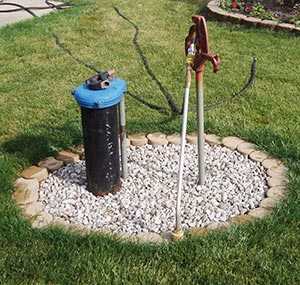Grantee Success Stories
Below are success stories from health departments working to reduce exposures from private wells. These health departments were funded under a previous cooperative agreement cycle with CDC. As the new grantee projects advance, additional success stories will be added. Some grantees have promoted additional testing of the most likely contaminants to increase the number of private well owners who are actively testing their water. Others are tailoring their communication to homeowners to explain what test results mean and what treatment options to consider.

Common household private well pump in a back yard.
Cerro Gordo County Department of Public Health (Iowa) took action to strengthen their program’s ability to reduce exposure to arsenic from private well water. Local officials tested water and rock chip samples from more than 60 wells and determined the source of the arsenic in this community (pyrite). Local environmental health supervisors then classified the entire county as an “arsenic zone” and approved an ordinance to require well testing to reduce risk for exposure to high arsenic levels in wells. They also worked with well drillers to change well construction practices to prevent arsenic exposure. Additionally, the state updated rules contained in the Grants-To-Counties Program to reimburse residents for arsenic testing in private wells. This will benefit 450,000 private wells users.
New Hampshire Department of Environmental Services (NHDES) collaborated with a local college to identify the factors that limit private well testing and treatment rates. In New Hampshire, almost half of the residents rely on private wells, and about one in five private wells present unsafe levels of arsenic. The state health department targeted at-risk populations with effective water testing and treatment interventions and set a goal to increase private well testing by 25 percent. In addition, the state addressed a major barrier to private well testing and treatment by creating an on-line application providing individualized water treatment guidance to private well users based on their water testing results.
Connecticut Department of Public Health (CTDPH) conducted a statewide sampling survey of private wells and collected samples during the promotion of free well testing at state agricultural fairs. As a result of these efforts CTDPH identified 151 wells with elevated levels of arsenic and uranium. They organized a statewide educational campaign using various communication outlets (newspaper, video, social media) to promote well testing and developed an informational fact sheet [PDF - 1.36 MB] to communicate private well risks. Additionally CTDPH collected and organized private well water data from individual towns and the CTDPH State Laboratory using their state health information system, MAVEN, which allows laboratory data to be shared electronically with disease prevention programs. CTDPH is also a current Safe WATCH grantee. Their current work is focused on following up with owners of contaminated wells to determine if they have taken public health action to prevent exposure to contaminants.
- Page last reviewed: April 25, 2016
- Page last updated: April 25, 2016
- Content source:


 ShareCompartir
ShareCompartir